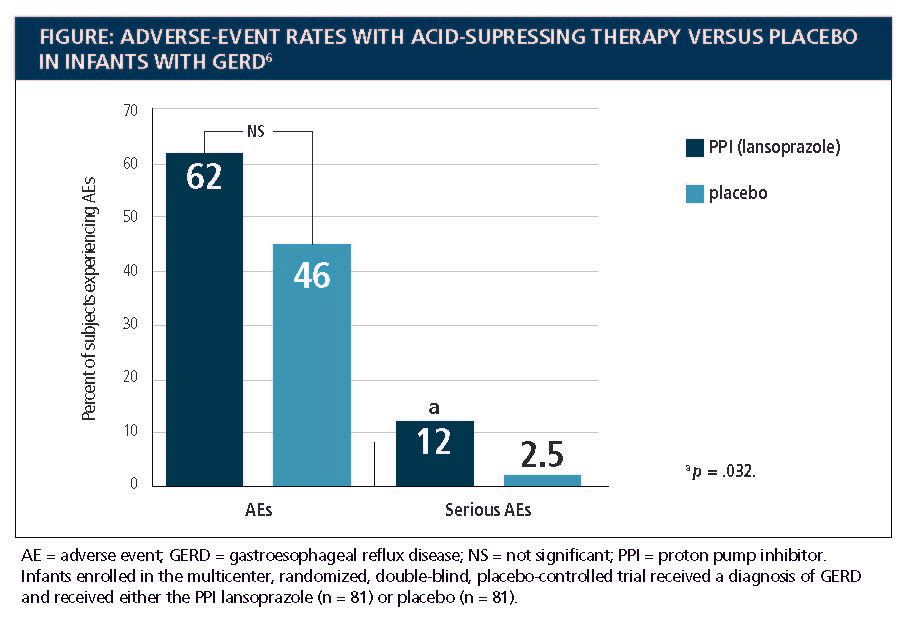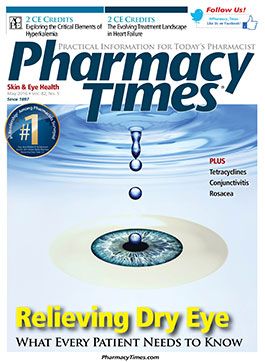Publication
Article
Pharmacy Times
Management of Gastroesophageal Reflux in Infants and Children
This article was sponsored by Mead Johnson Nutrition.
Gastroesophageal reflux, or GER, is defined as the physiologic passage of gastric contents into the esophagus.1 GER, which is caused by transient relaxation of the esophageal sphincter, is a normal physiologic process that occurs at least once daily in healthy infants aged 3 to 4 months. Because this regurgitation in infants is normal, it may occur in association with a wide range of physiologic and pathologic conditions. This normal occurrence leads approximately 1 in 5 caregivers to seek medical help.2
GER may be associated with a separate clinical entity, gastroesophageal reflux disease (GERD). Unlike GER, however, GERD may manifest with extraesophageal symptoms such as cough, laryngitis, pharyngitis, sinusitis, recurrent otitis media, and dental erosions.1 Underlying conditions associated with GERD include comorbid disorders such as neurologic impairment, esophageal atresia, and prematurity, which occur in more than three-fourths (80%) of children who require long-term GERD therapy.2,3 In patients with these signs and symptoms, endoscopically diagnosed esophagitis, food aversion, feeding difficulties, repeated regurgitation episodes, nutrient loss, and poor weight gain may help establish a definitive diagnosis of GERD.1
Management of GERD
In cases of GERD, when pharmacologic therapy is needed, acid suppressants have been the main treatment. However, because of the potential risks involved with these agents, other strategies may be advisable.2
Use of Acid Suppressors
When used appropriately, acid-suppressing agents such as histamine-2 receptor antagonists (H2RAs) and proton pump inhibitors (PPIs) are effective at reducing gastric acidity and healing esophageal erosions in children with GERD.1 Because of their short duration of action, H2RAs may need to be administered 2 to 3 times daily and may become less effective with continued use. Unlike H2RAs, the acid-suppressing effects of PPIs do not diminish with long-term use. Of the PPIs, omeprazole, lansoprazole, and esomeprazole are approved for use in North America in children 1 year and older; few studies have involved infants younger than 1 year.2
GER = gastroesophageal reflux, the physiologic passage of gastric contents into the esophagus.
GERD = gastroesophageal reflux disease, a separate clinical entity associated with GER that may manifest with extraesophageal symptoms such as cough, laryngitis, pharyngitis, sinusitis, recurrent otitis media, and dental erosions.
Potential Risks of Acid-Suppressing Therapy
Although acid suppressors can be effective when used properly, there are other considerations. Gastric acid may have a physiologic role in limiting the growth and survival of ingested microorganisms.4 Disrupting this physiologic process through acid-suppressing therapy in infants may be a risk factor for community-acquired pneumonia, gastroenteritis, and Clostridium difficile infection (CDI).1,5
In 2006, Canani and colleagues identified an increased risk of community-acquired pneumonia and gastroenteritis in children aged 4 to 36 months with GERD-related symptoms that were treated with acid suppressants. For the study, children who had not been treated with acid suppressants in the 4 months prior to enrollment received treatment with either ranitidine, an H2RA, or omeprazole, a PPI, for 8 weeks. Over 4 months of follow-up, 91 children who received gastric-acidity inhibitors were compared with 95 similar healthy control children who did not receive medication. The odds ratio of developing acute gastroenteritis was elevated by a factor of 3.58 in children using acid-suppressive therapy, and the risk of pneumonia was elevated 6.39-fold.4

In a 2009 multicenter, randomized, double-blind, placebo-controlled trial assessing the efficacy and safety of the PPI lansoprazole in infants with GERD symptoms (n = 81) compared with infants with GERD symptoms receiving placebo (n = 81), Orenstein and colleagues identified no significant differences in response rates or symptom-reduction scores. However, researchers did identify a significantly greater rate of serious adverse events (AEs) in infants assigned to receive lansoprazole (10 cases vs 2 cases; p = .032). Treatment-emergent AEs occurred in nearly two-thirds (62%) of infants treated with lansoprazole compared with fewer than half (46%) of infants treated with placebo (p = 0.058; Figure6).6
In a 2015 study, Freedberg and colleagues identified an increased risk of CDI in infants and children receiving acid-suppressive therapy. Infants, children, and young adults aged 0 to 17 years receiving acid-suppressive medication (n = 650 patients) were each matched with up to 5 control patients (n = 3200 controls). Researchers identified a more than 7-fold greater risk of infection in users of acid-suppressive therapy versus comparable control patients (adjusted odds ratio [OR] 7.66; 95% CI, 3.24-18.1). The risk of CDI was elevated more than 5-fold in infants younger than 1 year (OR: 5.24; 95% CI, 1.13-24.4).5
Management of GER
Lifestyle changes are recommended as initial management of GER.2 GER can be addressed with conservative management, which includes guiding caregivers to implement lifestyle strategies such as changes in diet and positioning of the infant, avoiding overuse of medications, and minimal use of testing. Conservative management is indicated for uncomplicated physiologic reflux typically associated with GER.1
Feeding Considerations
Dietary changes, such as switching to thickened formulas, may help address GER in formula-fed infants. Guidelines recommend this strategy for formulafed infants who are otherwise healthy and have GER or GERD.1,2 It is important to note that adding rice cereal to conventional formulas may change the product’s osmolarity, energy density, and macronutrient makeup. Commercially available thickened formulas, such as Enfamil A.R., maintain appropriate caloric density and osmolarity levels,
and still provide support for the dietary management of GER
.2
In children who do not respond to initial dietary changes, GER may be associated with protein sensitivity. In formula fed-infants, switching to a formula containing hydrolyzed protein or amino acid may help.2 For breastfed infants, a 2- to 4-week trial of a maternal diet excluding cow’s milk protein or egg protein may be attempted.1
Other lifestyle changes may be helpful in GER management, including feeding children in an upright position; avoiding semi-supine positioning, such as in a car seat; avoiding overfeeding; and eliminating exposure to tobacco smoke to help reduce reflux.1,2
Role of the Pharmacist
Although pharmacologic treatment may be appropriate for certain patients who are at high risk for serious complications of confirmed GERD, the vast majority of infants respond to conservative management and observation. Pharmacists can serve an important role by educating parents about the risks and benefits of acid-suppressing therapy so that the parents can make an informed decision for their child in consultation with their child’s physician. By helping to reserve acid-suppressing therapy for infants and young children with GERD, pharmacists can help avoid the negative consequences of overprescription of acid-suppressing agents.
References
- Lightdale JR, Gremse DA; Section on Gastroenterology, Hepatology, and Nutrition. Gastroesophageal reflux: management guidance for the pediatrician. Pediatrics. 2013;131(5):e1684-e1695. doi: 10.1542/peds.2013-0421.
- Vandenplas Y, Rudolph CD, Di Lorenzo C, et al; North American Society for Pediatric Gastroenterology Hepatology and Nutrition; European Society for Pediatric Gastroenterology Hepatology and Nutrition. Pediatric gastroesophageal reflux clinical practice guidelines: joint recommendations of the North American Society for Pediatric Gastroenterology, Hepatology, and Nutrition (NASPGHAN) and the European Society for Pediatric Gastroenterology, Hepatology, and Nutrition (ESPGHAN). J Pediatr Gastroenterol Nutr. 2009;49(4):498-547. doi:10.1097/MPG.0b013e3181b7f563.
- Hassall E. Over-prescription of acid-suppressing medications in infants: how it came about, why it’s wrong, and what to do about it. J Pediatr. 2012;160(2):193-198. doi: 10.1016/j.jpeds.2011.08.067.
- Canani RB, Cirillo P, Roggero P, et al; Working Group on Intestinal Infections of the Italian Society of Pediatric Gastroenterology, Hepatology and Nutrition (SIGENP). Therapy with gastric acidity inhibitors increases the risk of acute gastroenteritis and community-acquired pneumonia in children. Pediatrics. 2006;117(5):e817-e820.
- Freedberg DE, Lamousé-Smith ES, Lightdale JR, Jin Z, Yang YX, Abrams JA. Use of acid suppression medication is associated with risk for C. difficile infection in infants and children: a population-based study. Clin Infect Dis. 2015;61(6):912-917. doi:10.1093/cid/civ432.
- Orenstein SR, Hassall E, Furmaga-Jablonska W, Atkinson S, Raanan M. Multicenter, double-blind, randomized, placebo-controlled trial assessing the efficacy and safety of proton pump inhibitor lansoprazole in infants with symptoms of gastroesophageal reflux disease. J Pediatr. 2009;154(4):514-520.e4. doi:10.1016/j.jpeds.2008.09.054.








